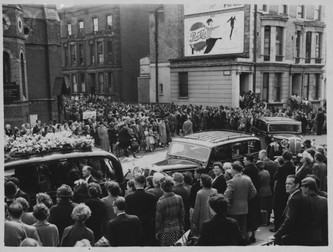Antiguan migrant whose murder sparked huge social change

Kelso Cochrane was an Antiguan carpenter murdered by a gang of white men on the streets of Ladbroke Grove in 1959. He was 32 years old when his life came to an abrupt end. The murder highlighted the hostility and racism that was rife at the time and sparked huge change.
History marks the murder as the first racially motivated killing after the Windrush generation migrated to Britain, but the police at the time treated it as a robbery gone wrong. Britain had welcomed the Caribbean migration in the wake of the war, yet hostility bubbled beneath the surface. Many recent arrivals settled in North Kensington, an area famous for low rents and unscrupulous landlords. Here, fascist politician Oswald Mosley focussed his energies, arguing for the repatriation of Caribbean people. His ideas were supported by a vocal minority, as the race riots of 1958 highlighted to the world. Black people suffered violent attacks from ‘Teddy Boys’ on both the roads and in their homes. The attacks only stopped when the Caribbean diaspora resisted, in the summer of 1958. Nine white rioters were handed four-year prison sentences, weeks before Cochrane's murder. The air of the time was thick with discord.
On the weekend Cochrane was set upon, many house parties were in full swing and he was walking home from hospital. He had a thumb injury from work and though he’d been treated earlier in the day, the throbbing pain gave him cause for concern. He was set upon on Southam Street; between four and six men accosted him and one stabbed him with a stiletto blade. There were witnesses to the attack, yet not one of them - it seemed - could identify the killer.
The police operation to find Cochrane’s killer was compromised in many ways. The suspected killer, Pat Digby, was investigated. He, along with his accomplices, were questioned and then put in adjoining cells which allowed them to agree their stories. They were released after 12 hours and the police lost the trail. Digby's murderous act was "the worst kept secret in Grove.” Rumours that the weapon was beneath a floorboard in his home abounded, but the police never conducted a search.
Those responsible for murdering Cochrane were never brought to justice. The police investigation of the murder came under much scrutiny. Friends, family and members of the local community were outraged. Activists like Claudia Jones took the police and press to task and marches to Whitehall followed. Huge shifts in race relations got under way and legislation was formed on foundations laid by activists in the streets, following the murder.
Yet the open sore from an unsolved crime festered. In 2003, Cochrane's brother Stanley tried to re-open the case. The police informed him that there was no forensic evidence as his brother's clothes had been incinerated in 1969; a route to justice was denied. Journalist Mark Olden assisted Stanley to get access to the evidence. The police denied the request, saying that they may still open the case at a later date. An informal investigation followed in which Olden was able to point - as conclusively as possible - to Digby. Olden's book ‘A Murder in Notting Hill,’ goes a long way towards the truth, but justice was not served.
Fifty years after Kelso’s killing, in 2009, a blue plaque was put up to mark the place of the murder. Local artist, Alfonso Santana, created the mosaic portrait of Cochrane on his grave. Local trade unionist, Eddie Adams, led the initiative. Cochrane's death is marked annually on Southam Street.
History marks the murder as the first racially motivated killing after the Windrush generation migrated to Britain, but the police at the time treated it as a robbery gone wrong. Britain had welcomed the Caribbean migration in the wake of the war, yet hostility bubbled beneath the surface. Many recent arrivals settled in North Kensington, an area famous for low rents and unscrupulous landlords. Here, fascist politician Oswald Mosley focussed his energies, arguing for the repatriation of Caribbean people. His ideas were supported by a vocal minority, as the race riots of 1958 highlighted to the world. Black people suffered violent attacks from ‘Teddy Boys’ on both the roads and in their homes. The attacks only stopped when the Caribbean diaspora resisted, in the summer of 1958. Nine white rioters were handed four-year prison sentences, weeks before Cochrane's murder. The air of the time was thick with discord.
On the weekend Cochrane was set upon, many house parties were in full swing and he was walking home from hospital. He had a thumb injury from work and though he’d been treated earlier in the day, the throbbing pain gave him cause for concern. He was set upon on Southam Street; between four and six men accosted him and one stabbed him with a stiletto blade. There were witnesses to the attack, yet not one of them - it seemed - could identify the killer.
The police operation to find Cochrane’s killer was compromised in many ways. The suspected killer, Pat Digby, was investigated. He, along with his accomplices, were questioned and then put in adjoining cells which allowed them to agree their stories. They were released after 12 hours and the police lost the trail. Digby's murderous act was "the worst kept secret in Grove.” Rumours that the weapon was beneath a floorboard in his home abounded, but the police never conducted a search.
Those responsible for murdering Cochrane were never brought to justice. The police investigation of the murder came under much scrutiny. Friends, family and members of the local community were outraged. Activists like Claudia Jones took the police and press to task and marches to Whitehall followed. Huge shifts in race relations got under way and legislation was formed on foundations laid by activists in the streets, following the murder.
Yet the open sore from an unsolved crime festered. In 2003, Cochrane's brother Stanley tried to re-open the case. The police informed him that there was no forensic evidence as his brother's clothes had been incinerated in 1969; a route to justice was denied. Journalist Mark Olden assisted Stanley to get access to the evidence. The police denied the request, saying that they may still open the case at a later date. An informal investigation followed in which Olden was able to point - as conclusively as possible - to Digby. Olden's book ‘A Murder in Notting Hill,’ goes a long way towards the truth, but justice was not served.
Fifty years after Kelso’s killing, in 2009, a blue plaque was put up to mark the place of the murder. Local artist, Alfonso Santana, created the mosaic portrait of Cochrane on his grave. Local trade unionist, Eddie Adams, led the initiative. Cochrane's death is marked annually on Southam Street.

